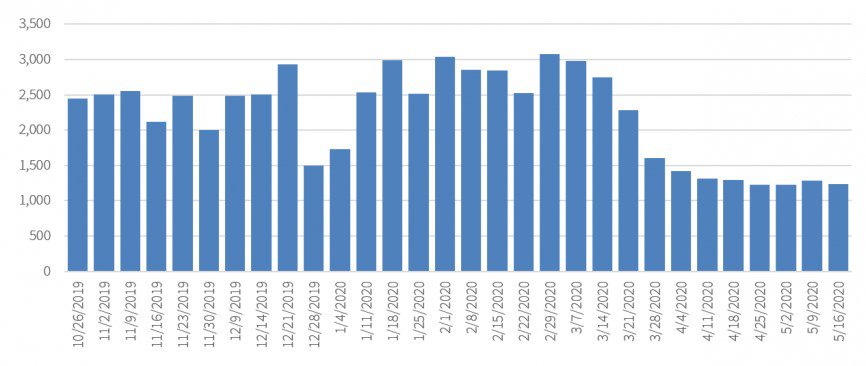What Has Been The Effect Of COVID-19 On Immigration Processing Inside The United States?
As of April 24, 2020, USCIS suspended all in-person services at its offices through at least June 4, 2020. As a result, interviews for all immigration benefit applications and asylum applications are postponed and will be rescheduled when normal operations resume. USCIS also “temporarily suspended” all biometrics appointments, meaning that new fingerprints cannot be taken. The agency suspended naturalization oath ceremonies, although a very limited number of small ceremonies have taken place in some jurisdictions. This has unnecessarily delayed the ability of tens of thousands of immigrants to become U.S. citizens. The agency has also made a number of technical changes to the H-2A and H-2B processes which make it easier for noncitizens who are working to keep the nation’s food supply stable to remain in the United States for the duration of the national emergency.
However, the agency has resisted calls to grant automatic status extensions or otherwise make changes which would prevent foreign nationals from inadvertently losing status during the current national emergency declared by the president on March 13, 2020.
What Impact Has COVID-19 Had On Immigration Enforcement And Detention Inside The United States?
Every day, ICE Enforcement and Removal Operations officers detain noncitizens across the United States for alleged violations of immigration law. Individuals in ICE custody include undocumented immigrants and people with lawful immigration status such as visitors, international students, temporary workers, or LPRs. People detained by ICE are held in a network of detention centers around the country which includes private facilities operated for profit, state and local jails, and dedicated ICE facilities. Some of these facilities are also used to detain people arrested at the border by CBP, including thousands of people seeking asylum.
The Effect of the Coronavirus on ICE Enforcement Practices
In response to the coronavirus pandemic, ICE has been forced to limit its enforcement actions throughout the United States. While the agency did not fully suspend arrests, it promised to “temporarily adjust its enforcement posture” beginning on March 18, 2020, by “focus[ing] enforcement on public safety risks and individuals subject to mandatory detention based on criminal grounds.
The effect of ICE’s limited enforcement became quickly apparent, with the agency sending fewer people to ICE detention centers in the weeks after the change in policy (see Figure 5). In the week ending on March 14, 2020 ICE arrests led to 2,751 people sent to detention. That dropped to 1,608 by the end of March and dropped further still throughout April.
ICE Interior Apprehensions resulting in Detention by Week, FY 2020

Source: Immigration and Customs Enforcement, “Detention Management: Detention Statistics,” https://www.ice.gov/detention-management. Prior weekly data on file with authors.
ICE also made changes to its policy of requiring some immigrants released from detention and placed on an “order of supervision” to check in with the agency periodically. All in-person check-in appointments were suspended, as were home visits. In the interim, ICE required some individuals to check in by phone instead, or through apps and other technological solutions.
The Effect Of Coronavirus On Deportations
Despite a drop in immigration enforcement inside the United States, ICE has continued to deport people to countries around the world, even though this threatens to further spread the coronavirus. Initially, ICE indicated that it was conducting temperature checks for all individuals prior to boarding removal flights, sending anyone to a hospital whose temperature was 100.4 degrees or above. This was later reduced to 99 degrees. On April 23, 2020, ICE announced that it would begin coronavirus testing some individuals prior to deportation.
In mid-April, dozens of people deported to Guatemala—all of whom spent time in ICE detention centers—tested positive for the coronavirus. Guatemala responded by suspending deportation flights temporarily. In response to Guatemala and other countries threatening or suspending deportation flights due to the pandemic, the White House issued a memorandum on April 10, 2020, that threatened visa sanctions on any country that refused to accept ICE deportation flights. The memorandum declares that any government which “denies or unreasonably delays the acceptance” of deportation flights from the United States will be targeted with visa sanctions under Immigration and Nationality Act section 243(d).
Despite this memorandum, Guatemala has not been sanctioned for temporarily halting some deportation flights. However, the spread of the virus inside Guatemala has been directly attributed to ICE deportation flights. By the end of April, 20 percent of the country’s positive cases were from ICE deportation flights. In May, Guatemala resumed deportation flights, after ICE promised to test all individuals deported to that country and certify that they were not positive for the virus. On May 15, after multiple individuals certified by ICE as not having COVID-19 tested positive after being deported to Guatemala, deportation flights were suspended again.
For more information on Effect Of COVID-19 On Immigration Processing, an initial consultation is your next best step. Get the information and legal answers you are seeking by calling (817) 532-5666 today.


 Tiếng Việt
Tiếng Việt


